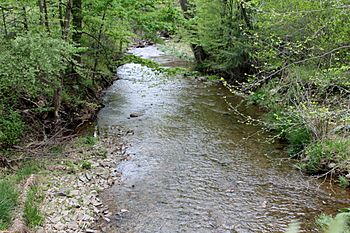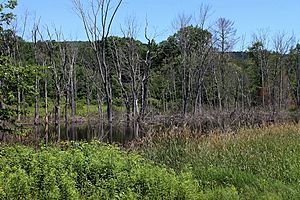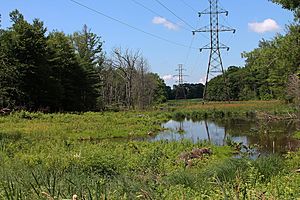Stony Brook (Fishing Creek tributary) facts for kids
Quick facts for kids Stony Brook |
|
|---|---|

The lower reaches of Stony Brook
|
|
| Physical characteristics | |
| Main source | North Centre Township, Columbia County, Pennsylvania |
| River mouth | Fishing Creek in Orange Township, Columbia County, Pennsylvania 528 ft (161 m) 41°02′52″N 76°25′44″W / 41.0479°N 76.4289°W |
| Length | 4.3 mi (6.9 km) |
| Basin features | |
| Basin size | 3.72 sq mi (9.6 km2) |
Stony Brook is a small stream in Columbia County, Pennsylvania. It flows into a larger stream called Fishing Creek. Stony Brook is about 4.3 miles (6.9 km) long. It flows through two areas: North Centre Township and Orange Township.
The area of land that drains water into Stony Brook is called its watershed. This watershed covers about 3.72 square miles. For much of its path, the stream flows through a steep, narrow valley. Many different kinds of plants grow here. Long ago, in the 1870s, people thought about using Stony Brook as a source of drinking water.
Contents
Where Stony Brook Flows
Stony Brook begins in the northwestern part of North Centre Township. It starts near the southern edge of Knob Mountain. The stream first flows southwest. It quickly crosses a road called Pennsylvania Route 93.
Soon after, Stony Brook leaves North Centre Township. It then enters Orange Township. It keeps flowing southwest and enters a valley. This valley becomes steeper as the stream turns south, then west. It flows north of a place called Summer Hill. Finally, the stream crosses Pennsylvania Route 487. Shortly after, it joins Fishing Creek.
Stony Brook meets Fishing Creek about 8.1 miles (13.0 km) before Fishing Creek reaches its own end. It also joins Fishing Creek about 1 mile (1.6 km) upstream from the town of Lightstreet.
The Land and Water of Stony Brook
Stony Brook flows through a valley that is steep and narrow in some parts. The stream is about 528 feet (161 m) above sea level. The bottom of Stony Brook is made up of many round stones called cobbles.
Near where Stony Brook joins Fishing Creek, you can see a special rock layer. It is called the Stony Brook Beds. This rock layer is made of shale, which is a type of soft rock. It has many fossils inside it. These fossils include two types of ancient sea creatures called spirifiers.
The area around Stony Brook helps keep its water clean. The water in the stream is usually very clear. However, water flowing off nearby farms and homes could make the water less clean. This is called runoff.
Stony Brook's Watershed
The land area that drains into Stony Brook is very important. In 2004, experts called it a "locally significant site." The watershed covers 3.72 square miles. Stony Brook does not have any smaller streams flowing into it. The stream is located on the Bloomsburg map from the USGS.
The valley around Stony Brook is mostly covered in forests. It has not been built on much. There are farms and houses near the valley. But there is no road going through the valley itself. Experts strongly advise against building a road there. They say it would harm this special stream.
History of Stony Brook
In the 1870s, the Bloomsburg Water Company tried to use Stony Brook for drinking water. But they were not successful. In 1938, a strong concrete bridge was built over Stony Brook. This bridge is 33.1 feet (10.1 m) long. It carries Pennsylvania Route 487 over the stream.
In 2009, 25 local volunteers worked together. They cleaned up over 17 tons of trash. This trash had been left at the spot where Stony Brook meets Fishing Creek. It was left there after a big flood in 2006.
Stony Brook got its name because there are many rocks, or "stones," found near it.
Plants and Animals of Stony Brook
The Pennsylvania Department of Environmental Protection has given Stony Brook a special protection status. It is called an "Exceptional Value Stream." This means it has legal protection to keep its water and environment healthy.
The trees in the valley of Stony Brook are mostly hemlock trees. You can find hemlocks of all different ages here. Other trees growing in the valley include beech, basswood, two types of oak, yellow birch, black cherry, pignut hickory, tulip poplar, white ash, and sugar maple.
The bottom of the valley also has many smaller plants. There are especially many ferns, with nine different kinds recorded.
Wildflowers and Other Plants
Native woodland flowers grow along the edges of Stony Brook. These include:
- blue cohosh
- false hellebore
- twisted stalk
- miterwort
- golden saxifrage
- barren strawberry
- false Solomon's seal
- Solomon's seal
- Canada violet
- purple trillium
- wild stonecrop
- trout lily
- dwarf ginseng
- white baneberry
An overhead power line crosses the Stony Brook valley in one spot. Near this power line, you can find many invasive plants. These are plants that are not native and can harm the local environment. One example is multiflora rose.
There are also small numbers of an insect called the hemlock woolly adelgid. This insect is considered a pest. If there were too many of them, they could damage the hemlock forests in the watershed.



